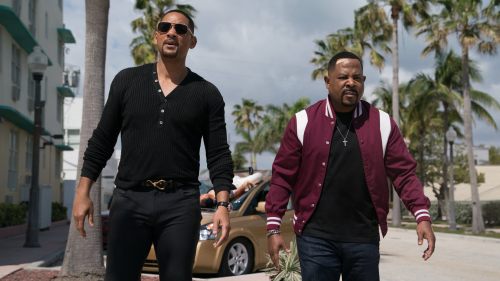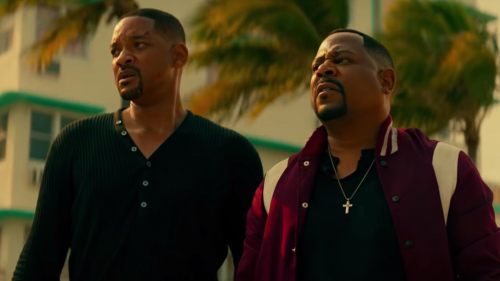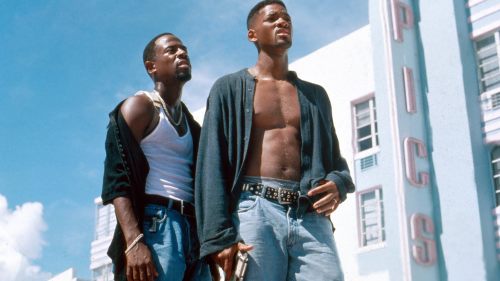An American Hummer in Cuba: The Consciousness-Shattering Severity of BAD BOYS II
Watching the first Bad Boys twenty years after it initially hit theaters, Michael Bay’s feature directorial debut feels quaint in comparison to everything else the maestro of mayhem would go on to produce. As a matter of fact, the movie is dwarfed even when placed alongside Tony Scott’s massive, ego-driven sequel to Beverly Hills Cop. That picture’s DNA courses through the veins of Bay’s introduction to the silver screen; an apathetically produced, ultraviolent, MTV-generation masterwork so fueled by brazen hubris that it sees Axel Foley driving a foreign luxury sports car through America’s automobile manufacturing headquarters not too long after “Eddie Murphy Productions” is plastered over the comedian’s Speedo-clad cock. As Bob Seger’s “Shakedown” scores the opening credits, it’s pretty clear from the word “go” that the chummy vibe of the original is going to be eschewed completely and replaced with an avalanche of shtick.
Bay was barely thirty when the first Bad Boys came out; fresh chuck for the Jerry Bruckheimer/Don Simpson grinder, with a solid portfolio of commercial work, Meat Loaf and Great White videos to his name. The result is a rather routine cop film; following spoiled rich kid Mike Lowrey (Will Smith) and family man Marcus Burnett (Martin Lawrence) as they sow their homoerotic oats while on the trail of a stolen mob heroin load. To label the picture “intimate” isn’t completely out of line, as Smith famously fought with Bay over the ending of the film, bucking against the decision to have Mike tell Marcus that he loves him. Ultimately, Bay got his way (as he typically does), and the movie kept its ending intact, cementing the dynamic, foul-mouthed duo as the Miami cousins to Foley’s fast-talking, Motor City rogue.
There are clues peppered throughout Bad Boys as to what Bay would eventually become, most prominently showcased in the vehicular fetish that defines Mike Lowrey’s status as a playboy scallywag. Lowrey drives a ’94 Porsche 911 Turbo 3.6 – a vehicle so essential to the movie’s overall Miami chic aesthetic (which no doubt owes a huge debt to Michael Mann’s own televised take on the city’s car-obsessed narcotics cops) that it’s printed on the picture’s poster. Dealing with a relatively meager budget (believe it or not, Bay actually made Bad Boys for under $20 million), the director actually lent his own ride to the production so that the character could feel complete.
In the years that followed, Bay’s affection for motor vehicles became more and more pronounced as his resources ballooned. The Rock saw Nic Cage chasing Sean Connery through the streets of San Francisco in a Ferrari F355, as Connery’s master escapist mans the wheel of a beastly black Hummer H1. Armageddon shoots Bay’s fascination into space, as an Armadillo ATV roars over the surface of an asteroid, carrying with it the equipment needed to stop the hurtling planetoid from destroying Earth. Later, the Transformers series would ostensibly act as the culmination of Bay’s fixation, as our intergalactic robot heroes hide themselves inside of Camaros and Mac Trucks. In essence, motor vehicles are a key component to Bay’s odd, overbearing auteurist fingerprint.
However, none of Michael Bay’s movies allow these fast cars to become barreling thematic juggernauts quite like Bad Boys II, a motion picture that attempts to stuff thirty pounds of “go fuck yourself” into a five pound bag. Ever the dutiful propagandist, Bay may have created the most “Capital A” Ugly American Movie of all time. Stuffed to the gills with bullets, silicone, Henry Rollins, KKK members, two Ferrari Maranellos (one of which Bay also owned) and Martin Lawrence rolling on high-powered ecstasy, Bad Boys II is basically how Bay envisions the collective nightmares of France. Not only do Mike and Marcus re-introduce themselves by throwing off Klan robes and screaming "damn...it's the nigras" (immediately after Bay’s director credit is superimposed over a flaming cross), they also get to meritoriously stomp out the dreams of white club kids everywhere via a war with a coked out Tony Montana wannabe (Jordi Mollà, essentially reprising his role from the end of Blow). All of this alone would make for a diverting hundred minute action bonanza.
Not so fast, though. Bay isn't content with simply remolding the two cops in the image of gun-toting Greek Gods (who both arguably share a barely closeted interest in similar sexual cravings), opting to let them run a Hummer (see the trend?) quite literally through a Cuban shantytown. It's Blaxploitation as viewed through the lens of a guy who wanted to sign up for the Navy after first seeing Top Gun. Political subtext is replaced by an overt "World Police" po-faced melodrama and unsubtle homophobia (to mask the characters’ gayness, of course). It'd be troubling if it weren't so glorious in its gluttony, the picture's wanton sensory assault pounding the viewer into complete submission for nearly three hours. Stumbling out into the street and letting the cold winds of life whip at their countenances after the credits roll, it's only then that audience members begin to ponder just how in the fuck this modern cinematic Caligula got Bruckheimer to pony up so much cash in support of his gargantuan "America! Fuck Yeah!" fiesta.
The answer to that question: the man knows how to shoot action. Hate him all you want (and there’s plenty to despise, from the ADD-addled editing on down), Bay can envision and lens a spectacular set piece in his sleep. From the 360 degree rotating shootout with a crew of Haitian stereotypes (who all sport heavy firepower), to the militarized gear of the TNT drug enforcement crew, Bay’s constant visual flexing is a wonder to behold. Framing helicopters as they soar overhead like metal birds of prey, Bay took lessons from greats like James Cameron and Tony Scott to heart, without once utilizing any of those masters’ controlled camera movements. Guns and tech and massive explosions click with his lizard brain, driving him to capture it all with a class showoff mentality, hoping to thrill in a purely visceral sense. At the same time, Bay has almost zero understanding of how human beings interact with one another, as these flesh suits (including Smith and Lawrence) are merely plasma-filled action figures he can place in harm’s way.
Yet Bay’s anti-human tendencies aren’t completely brought to the forefront until a car chase during the back half of Bad Boys II. This comes after the movie’s other infamous Ferrari freeway fracas (which involves a fleet of cars and a goddamn boat being mangled with nary a concern for his camera*). After breaking into a morgue and finding that the highly powered ecstasy is being ferried about the city via coffins, the two detectives engage in a high-speed pursuit that involves a load of frozen bodies being dumped out the back of a morgue van. Cadavers are decimated and decapitated, as Bay’s disdain for human life is utilized in service of constructing the world’s most hideous Go Kart track. The dead are not meant to be memorialized, and are instead reduced to hideous Mario Kart banana peels as, to Bay, they barely even served a purpose in life.
Possibly the most insane American power fantasy committed to film caps the movie, as after Marcus’ sister (Gabrielle Union) is kidnapped and taken to Cuba, the two super cops team up with the CIA (no bullshit) in order to engage in combat on the shores of Castro’s country. The Humvee Bay so loved in the The Rock returns (only now it’s yellow instead of black – adding a surrealist pop to the picture) as the boys careen down a massive hill, destroying shacks without a care in the world outside of saving Marcus’ kin. For those keeping a tally, Bay has now declared cinematic war on the gays, the obese (just watch as Mollà’s kingpin barely tolerates his portly daughter) and now the poor, flipping the bird to any semblance of basic dignity. When you combine the three massive car chase sequences together, it becomes rather clear that only one thing motivates the filmmaker: excess in the name of spectacular ophthalmic bombast.
The base want (strike that -- need) to reject Bad Boys II on both moral and intellectual grounds is wholly understandable. Once the film careens into Cuba, mercilessly running down nameless impoverished folks in service of entertainment, it becomes borderline reprehensible. You are practically waiting for a sequence where the production sneaks into Castro's compound, guerrilla style, allowing Bay to launch himself at the then seventy-six-year-old dictator, screaming "SURPRISE DICKHEAD!" before popping two in his chest and tooting another line of blow off of Don Simpson's cold corpse. This is Bay’s revenge for getting shorted on the original film; a love letter to destruction that is as dumb as it is deafening. But to dismiss the movie’s electric current of psychosis is to reject what makes the very best exploitation appealing in a primal sense. These are the delusions of a madman who just happens to be graced with Jerry Bruckheimer’s checkbook. You either give into to the maniac's death grip or go down kicking and screaming. Ride or die, motherfucker. Make your choice.
*“The theory of this car chase,” Bay says in the DVD extras, “is to put cameras where cameramen would be killed doing these shots.”



